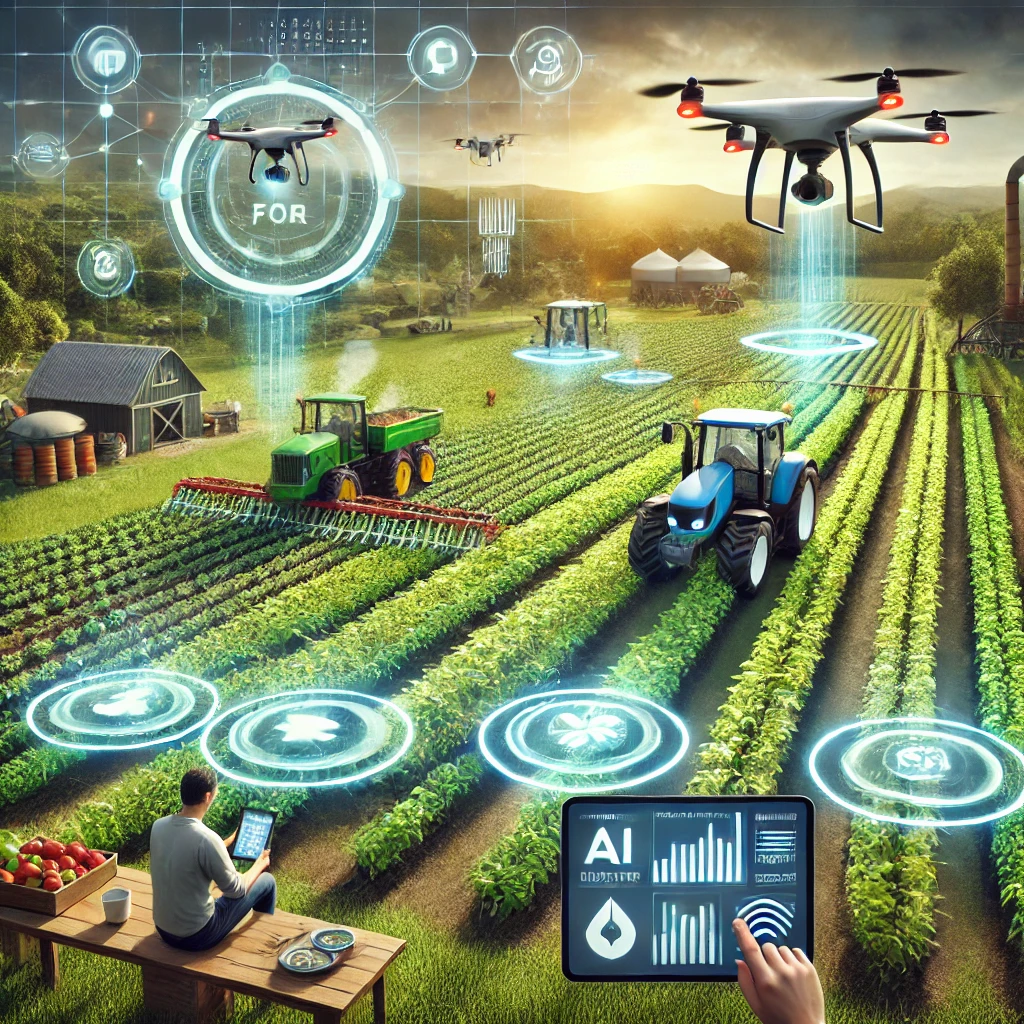Organized farming techniques have transformed significantly since ancient farming practices into present-day agricultural technology that considerably changes crop cultivation techniques and animal husbandry procedures. The implementation of advanced technologies including AI, IoT, drones and automation performs three functions for farming which are efficiency enhancement, sustainability improvement and production increase. Global food requirements continue to increase thus agricultural technology gained an essential position to safeguard food security and protect our environment.
What is Agricultural Technology?
The use of modern tools alongside equipment alongside systems under the term AgTech allows farmers to boost productive capabilities along with operational efficiency in their fields. The latest farming technologies assist farmers to boost their harvest quantities together with waste reduction and environmental damage reduction.
Key Benefits of Agricultural Technology:
- Higher Crop Yields – Increased efficiency through smart farming techniques.
- Water preservation becomes possible because of irrigated systems which minimize water losses.
- Labor expenses decrease due to automated systems that cut down on manual workforce at farms.
- Sustainable Farming practices develop programs that build biodiversity along with improving soil health in an eco-friendly manner.
- The utilization of precise monitoring enables farmers to enhance their resource management system.
- Technology-based disease and pest monitoring systems prevent extensive spread of infestations.
- Efficient Land Use – Maximizes agricultural output in limited space.
Types of Agricultural Technology
The farming industry encounters significant transformation through various modern tools and innovations which make up contemporary agricultural technology. These are among the most important technologies that have recently emerged in agriculture:
1. Precision Agriculture
The precision agricultural method makes use of GPS and IoT capabilities and AI power to enhance farming optimization. Through tracking data farmers acquire insights that help them base their decisions on scientific information.
- Smart Sensors – Monitor soil moisture, temperature, and nutrient levels.
- The automated irrigation system determines when to supply water to crops through combined analysis of actual weather conditions and soil condition data.
- Satellite remote sensing examines crops through images to diagnose health problems.
- AI-Based Yield Prediction – Analyzes data for better planning.
2. Drones in Agriculture
The agricultural drone revolution enables farmers to inspect crops from overhead and distributes pesticides while analyzing the condition of their soil.
- Aerial Imaging – High-resolution images for crop health monitoring.
- Precision agricultural spraying through drones enables them to distribute both fertilizers and pesticides.
- Livestock Monitoring – Tracks animal movement and health status.
- Directions and deployment of seeds become more efficient through drone planting procedures across agricultural fields.
3. Smart Farming with IoT
Farm management has received an improvement through IoT because devices now connect and submit real-time data. Smart Greenhouses – Automated climate control for optimal crop growth.
- Animal health and movement detection is possible through wearable devices used for livestock tracking.
- The implementation of AI-controlled systems serves to enhance the management of feed distribution.
- The remote operation of tractors and plows along with automated farm machinery constitutes the implementation of sophisticated farm equipment.
4. AI and Machine Learning in Agriculture
- Premodern information technology tools help farmers process agricultural data to forecast harvest volumes while streamlining operational systems.
- Utilizing artificial intelligence detects diseases in crops before they spread out for effective preventive measures.
- Yield Prediction Models operated by AI enable industry leaders to plan their markets more effectively through production forecasts.
- The combination of artificial intelligence with robots allows them to find weeds automatically then dispose of them.
- The robotics system aid pest control operations by eliminating the need for chemical pesticides.
5. Robotics and Automation in Farming
- Robotics technology has cut farming costs while boosting farm production levels because of automation.
- The process of autonomous tractor operation uses GPS navigation for functional independence.
- Artificial machines working together as harvesting robots streamline the process of collecting crops.
- The Farming Revolution uses AI to operate machines which handle the precise propagation of seeds.
- Robotic Milking Machines – Improve efficiency in dairy farming.
6. Vertical and Hydroponic Farming
- Urban farming strategies of today succeed in generating higher crop yields from small locations.
- Vertical Farming is a system of multileveled indoor agriculture that allows crop production throughout the whole year.
- Aeroponics and Hydroponics represent farming methods which substitute the typical soil component for water and air cultivation systems.
- The production efficiency of Controlled Environment Agriculture (CEA) depends on artificial lighting and climate control systems.
Aquaponics Systems – Combine fish farming with hydroponic plant growth.
The application of agricultural technology serves as a solution for resolving worldwide challenging situations. Current agricultural technology works to address major food production difficulties encountered by both farmers and producers across the world.
1. Food Security and Population Growth
- Smart farming stands as a resource that grows food sufficient to feed the expanding worldwide human population.
- The implementation of AI-based crop management enables competent resource utilization across the agricultural fields.
- The production volume of genetically modified crops with high yield capabilities continues to grow better.
2. Climate Change and Sustainability
- Precision farming systems help farmers cut down their consumption of water resources and chemical substances.
- Solar-powered irrigation linked to renewable energy provides farmers with an opportunity to practice sustainable agriculture.
- The implementation of Carbon sequestration methods results in improved fertility of the soil.
3. Reducing Agricultural Waste
- The combination of automation allows farmers to protect crops from spoilage and reduce losses after harvest.
- The implementation of blockchain technology enables better food tracking systems which cuts down fraud instances.
- The utilization of AI-controlled sorting technology decreases losses during food production cycles.
4. Labor Shortages in Agriculture
- The incorporation of robotics and AI-based automation prevents humans from labouring through their land.
- The implementation of autonomous devices allow large-scale farming operations to work more efficiently.
- AI-operated farm management systems help organizations plan their workforce requirements.
Future Trends in Agricultural Technology
Modern technological developments will drive evolution in agricultural systems to provide farmers with novel possibilities for innovative practices.
1. AI-Powered Agriculture
- Artificial Intelligence will maximize farm management processes through its ability to make accurate predictions.
- The decision-making processes of farmers will be supported by AI-powered chatbots.
- The analysis of data in real time boosts different resources’ distribution.
2. Blockchain for Food Supply Chain Management
- Food transparency from production to distribution will receive an enhancement through blockchain technology applications.
- Smart contracts enable agriculture to enhance equitable transactions between traders and establish better prices.
- Through digital ledgers food businesses can stop incidents of both fraud and counterfeiting.
3. Gene Editing & Biotechnology
- CRISPR along with gene-editing tools will produce disease-resistant plants that yield higher amounts.
- The implementation of biotechnology will develop environmentally beneficial pesticides along with sustainable fertilizers and control-methods.
- Targeting sustainability and development in farming will be facilitated by bioengineering practices.
4. Sustainable Energy in Agriculture
Agricultural operations will transition to power their operations with solar power together with wind energy and bioenergy systems.
- Farming tools with energy conservation features will diminish the farming sector’s carbon emissions.
- The smart grid technology will connect with farm energy infrastructure.
5. Smart Farms and Digital Twins
- AI technology will generate simulation models of agricultural fields for continual observation purposes.
- Yards and Vineyard administration programs in the cloud will merge capabilities from AI alongside IoT together with blockchain features.
- The implementation of smart sensors will help improve field conditions to stop vegetation from disappearing.
Conclusion
Agricultural technology maintains bright outlooks since innovative developments help agriculture maintain operations while increasing productivity while decreasing costs. A complete digital revolution now reshapes the modern agricultural industry through combination systems of AI crop oversight with robotic farms. Agricultural technology will continue its development trajectory for developing environmentally conscious farming solutions which fulfill the rising global food demands. The essential character of Ag Tech investments forces present-day agriculture to choose them as the only path for its future development.





